Eggplant Parmesan is a beloved Italian dish that traditionally involves slices of eggplant breaded and fried, layered with cheese and tomato sauce, and then baked. However, we’re embracing a healthier approach that does not compromise on taste. By baking the eggplant instead of frying, we achieve a light and crispy texture that’s both satisfying and better for our well-being.
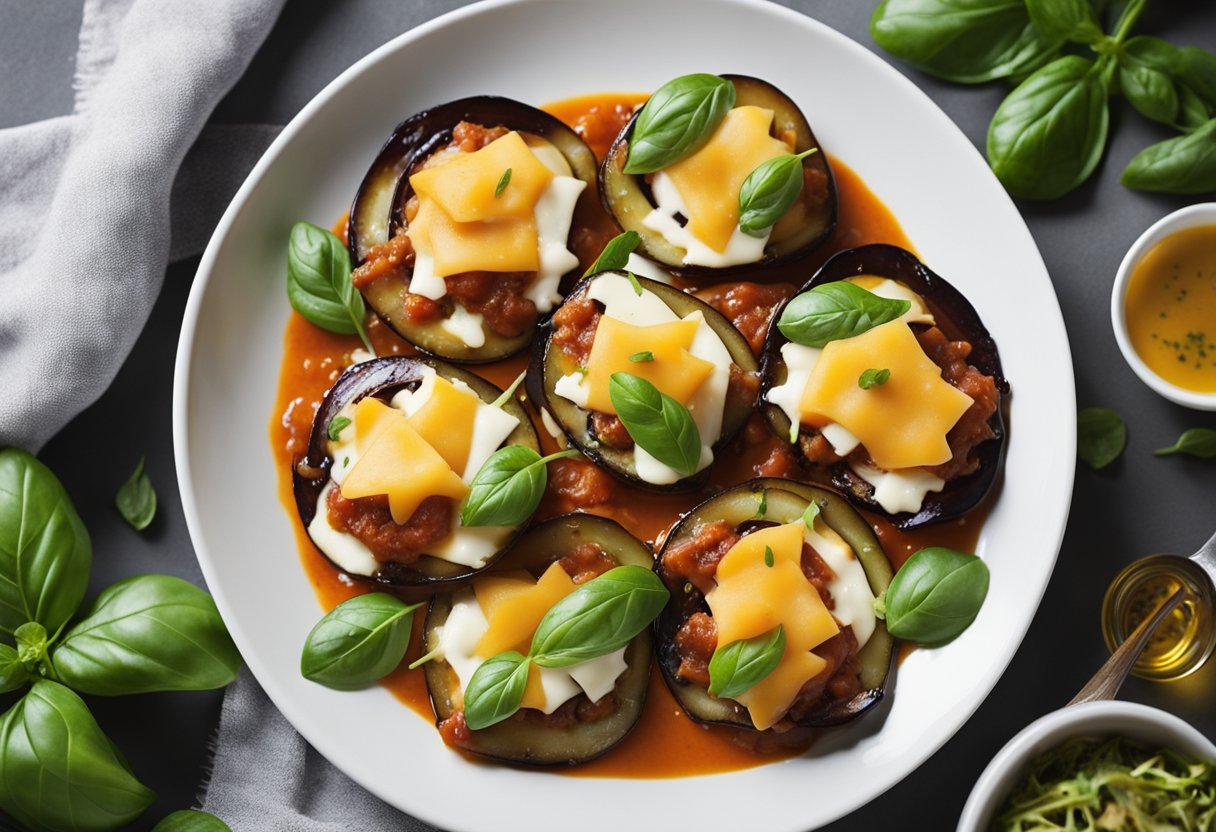
Our version of baked Eggplant Parmesan maintains that comforting, rich flavor profile of the classic but with fewer calories and less fat. We focus on highlighting the eggplant’s natural sweetness and creamy texture, complemented by the boldness of Parmesan cheese and the tang of a robust tomato sauce. This twist on the Italian staple is both an homage to tradition and an innovative step towards healthier eating without losing the essence that makes Eggplant Parmesan a timeless favorite.
Unveiling the Dish
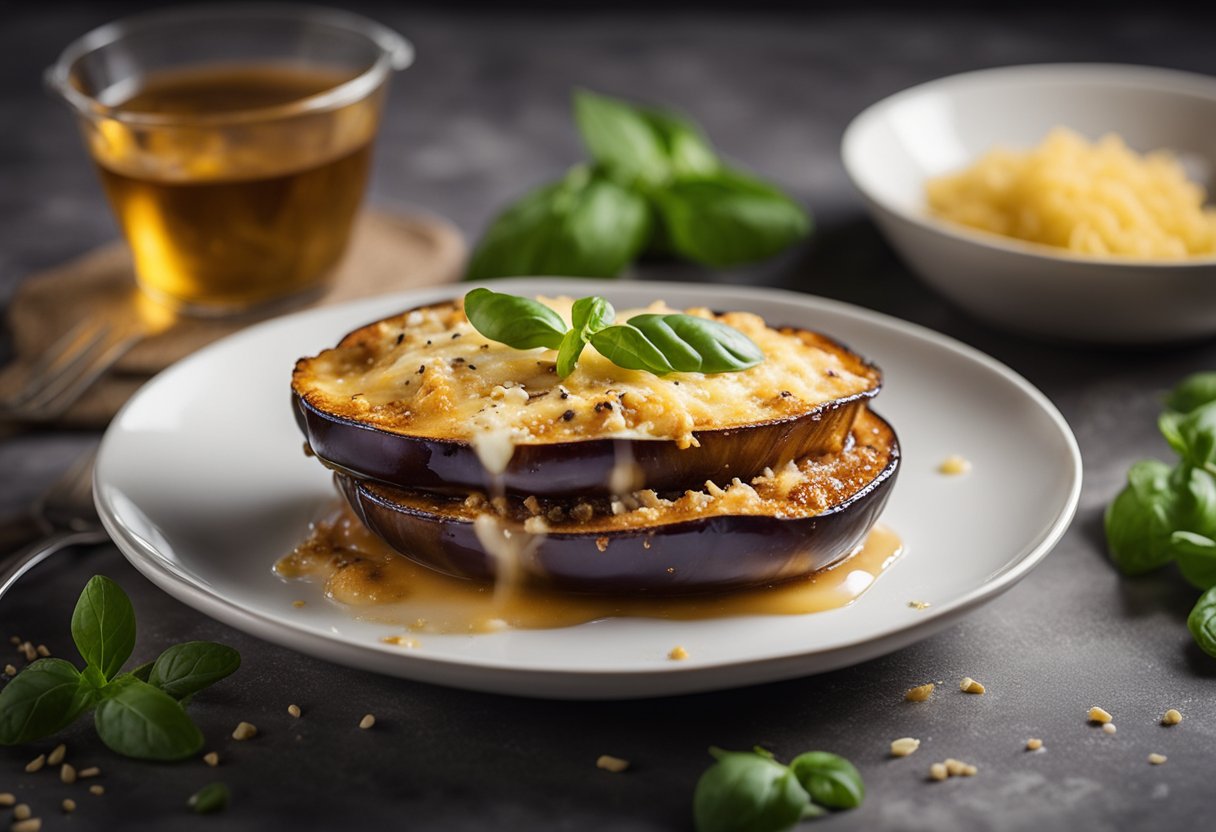
In this section, we’ll explore the Italian roots of eggplant parmesan, its potential health benefits, and how modern recipes are reimagining this classic dish with a healthier twist while maintaining that comforting satisfaction.
Origin of Eggplant Parmesan
Eggplant parmesan, also known as melanzane alla parmigiana, is a beloved Italian dish originally hailing from the Southern regions of Italy. Historians suggest that the name ‘parmigiana’ likely derives from the Sicilian word for latticework, alluding to the layered structure of the dish, which traditionally involves slices of eggplant layered with cheese and tomato sauce, then baked.
Health Benefits
As a vegetable-forward dish, eggplant parmesan can boast several health benefits when prepared with a lighter approach. Eggplants themselves are low in calories yet rich in fiber, which may support digestive health and weight management. When we opt for baking instead of frying, we reduce the calorie and fat content significantly, transforming comfort food into a healthier meal.
Comparing Traditional and Baked Variants
The traditional version of eggplant parmesan is known for its rich flavor, a result of the eggplant slices being fried before layering. However, we can still achieve a light and crispy texture without the added oils by baking. Here’s a quick comparison:
| Traditional Eggplant Parmesan | Baked Eggplant Parmesan |
|---|---|
| Fried eggplant slices add crunch but also calories and fat. | Baked eggplant slices retain a crispy texture with less fat. |
| Typically uses ricotta and mozzarella cheeses, which are higher in fat. | Can incorporate lower-fat cheese options without sacrificing flavor. |
| Usually served as a hearty main course. | Can serve as both a lighter main dish or a nutritious side. |
The baked variant not only aligns better with a health-conscious lifestyle but also maintains the essence of the classic Italian dish that so many of us cherish as comfort food.
Preparing the Ingredients

In creating a lighter version of baked eggplant parmesan, our focus is on selecting quality ingredients that will enhance both flavor and healthiness. We’ll guide you through picking the best eggplants, choosing cheese with both flavorful and melty qualities, deciding between homemade or store-bought marinara, and opting for healthier breading alternatives.
Eggplant: Selection and Preparation
We start with the eggplant, the star of our dish. Choose eggplants that are firm and heavy for their size, with smooth, glossy skin. Before we begin the actual cooking, we’ll prepare the eggplant by slicing it into 1/2-inch thick rounds. It’s not necessary to peel the eggplant; the skin contains nutrients and adds texture. However, to prevent a bitter taste, we can sweat the eggplant by salting the slices and letting them sit for about 10-15 minutes before patting them dry.
Cheese Choices
A trio of cheeses—mozzarella, parmesan, and if you prefer, fresh mozzarella—gives our dish its signature Italian taste and creamy texture. Mozzarella cheese is known for its meltability, which makes our dish delightfully stringy, while a good parmesan cheese, grated finely, adds a salty and nutty punch. We opt for fresh varieties of these cheeses, as they tend to be lower in sodium and free from unnecessary preservatives.
Homemade vs. Store-Bought Marinara
The marinara sauce is a crucial component that can make or break our eggplant parmesan. We always have the option to prepare it at home, ensuring control over the ingredients for a healthier result. But, if we’re short on time, a high-quality, preservative-free store-bought marinara can be a great alternative. Look for options with low sodium and no added sugars to keep it as healthy as possible.
Healthier Breading Alternatives
Traditional eggplant parmesan calls for a breadcrumb coating, but we can opt for breadcrumbs such as panko for a lighter but still crispy outcome. Go for whole wheat panko breadcrumbs when available for added fiber. To enhance the flavor, we’ll mix our breadcrumbs with garlic powder and some dried Italian herbs. This breadcrumb mixture will give us the crispy texture we desire without the heaviness of traditional frying methods.
Assembling the Dish

Before we dive into assembling our Light and Crispy Baked Eggplant Parmesan, let’s focus on the two pivotal stages: expertly layering the ingredients and finessing the baking process to achieve that perfect golden crust and bubbly cheesy goodness.
Layering Techniques
When constructing our Baked Eggplant Parmesan, the sequence of layering is crucial for balanced flavors and a cohesive dish. We start by choosing our baking dish wisely, ensuring it’s large enough to accommodate the layers without overcrowding.
- Initial Layer: Smear a thin layer of your favorite marinara sauce at the bottom of the dish. This acts as a flavor foundation and prevents sticking.
- Eggplant Slices: Take your seasoned, sliced eggplant—ensuring it’s coated evenly for that satisfying crispiness—and lay them down in an even, overlapping pattern. Each slice is a building block, so aim for complete coverage.
- Cheese and Seasoning: Sprinkle a generous helping of mozzarella and Parmesan cheeses, followed by a dash of Italian seasoning, to create a rich, flavorful profile.
- Repeat: Continue to build the layers by repeating the sauce, eggplant, and cheese sequence until all ingredients are utilized.
- Top Layer: Finish with a layer of cheese. This final cheesy barrier will create a golden, bubbly top once baked.
Remember, even pressure and spacing between the eggplant slices ensure even cooking and prevent sogginess.
Baking to Perfection
To achieve that irresistible crispy texture while keeping the eggplant parmesan light, we adhere to precise baking methods.
- Preheat: Always preheat your oven. This step guarantees that the baking process starts immediately and evenly.
- Temperature: We bake our dish at a high temperature, usually around 425 degrees Fahrenheit. This will crisp the outer layer while melting the cheese to perfection.
- Position in Oven: Center the baking dish in the middle of the oven to encourage uniform heat distribution.
- Timing: Bake until the top layer of cheese has turned golden and is bubbling with delight, usually between 20 to 30 minutes. Keep a watchful eye during the last few minutes to prevent burning.
By following these techniques, we ensure our Baked Eggplant Parmesan emerges from the oven with the right texture and tantalizing flavor.
Nutritional Considerations

When we opt for a light and crispy baked eggplant parmesan, we’re choosing a dish that can be rich in nutrients while being mindful of our caloric and fat intake. Here, we’ll explore the nutritional elements that make this dish a healthier alternative to the traditional fried version.
Caloric Content
Baked eggplant parmesan is typically lower in calories than its fried counterpart. By baking the eggplant, we avoid the extra calories that come from frying in oil. Recipes such as the one from EatingWell’s Eggplant Parmesan can offer a version with fewer calories without sacrificing the satisfying taste of the dish.
Sodium and Saturated Fats
One of the key nutritional considerations for any version of eggplant parmesan is the content of sodium and saturated fats. Cheese, one of the main ingredients, can be high in both. However, choosing low-fat mozzarella and monitoring the amount of parmesan can help limit saturated fat intake. Similarly, opting for low-sodium marinara sauce can keep sodium levels in check.
Fiber and Antioxidants Content
Eggplant is a great source of fiber and contains antioxidants, such as nasunin found in the skin, which may provide health benefits. Fiber is important for digestion and can help with feeling full. Pairing eggplant with a homemade marinara sauce that includes other vegetables can further boost the dish’s fiber and potassium content.
Fine-Tuning the Flavors
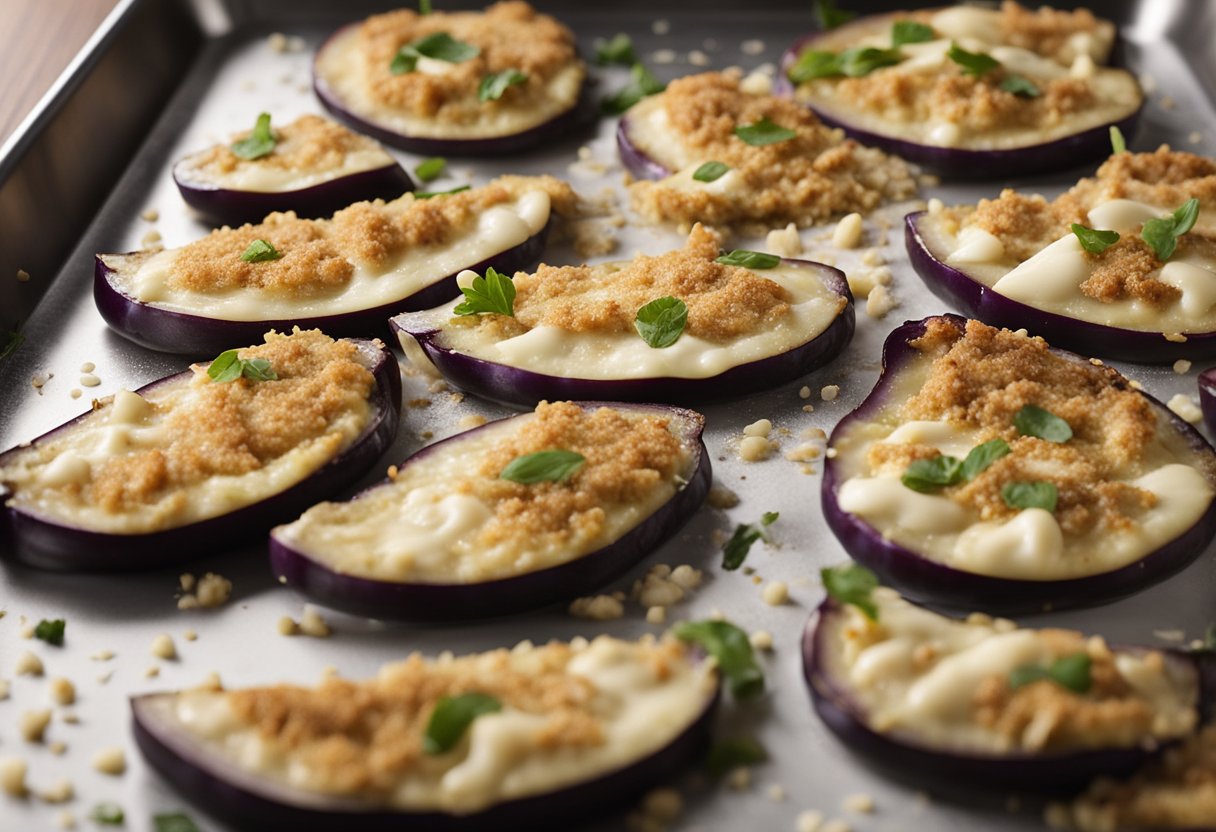
In crafting a light and crispy baked eggplant parmesan that sings with a healthy twist, we must pay due attention to the delicate balance of flavors. It is crucial that we select our herbs and spices with care and finesse our cheese and sauce ratios for a perfect harmony.
Herbs and Spices
The heart and soul of any Italian dish rest in its herbs and spices; our eggplant parmesan is no exception. Fresh basil is essential, lending its aromatic sweetness to the dish. We judiciously sprinkle dried oregano for its earthy, slightly bitter undertones. Liberal usage of garlic elevates the flavor profile, while a thoughtful pinch of salt and pepper enhances and sharpens the overall taste. Furthermore, a light drizzle of olive oil not only contributes a whisper of richness but also aids in achieving that desirable crispy texture.
- Fresh basil: A must for authentic flavor.
- Dried oregano: Adds depth to the dish.
- Garlic: Provides a robust foundation.
- Salt and pepper: Essential for highlighting all other flavors.
- Olive oil: Improves texture and adds a subtle complexity.
Balancing Cheese and Sauce Ratios
The right ratio of cheese to sauce is paramount in our version of eggplant parmesan. Too much sauce can render the dish soggy, while an overabundance of cheese might overwhelm and obscure the nuanced flavors. We strive for a balance with just enough marinara to moisten without drenching, creating a platform for the cheeses to melt and mingle without dominating. The use of fresh mozzarella offers creamy pockets of delight, and a judicious sprinkle of aged Parmesan imparts a salty, umami-laden counterpoint.
- Marinara sauce: Use sparingly to maintain crispness.
- Fresh mozzarella: Apply in moderation for creaminess.
- Grated Parmesan: A light sprinkle for a sharp, savory finish.
By keeping these considerations in mind, we ensure each bite of our healthy baked eggplant parmesan is not only wholesome but also a true reflection of Italian culinary artistry.
Finishing Touches

As we near the completion of our Light and Crispy Baked Eggplant Parmesan, focusing on the finishing touches can transform a good dish into a great one. The final steps are crucial for enhancing both the visual appeal and the taste. Let’s perfect the dish with a hint of freshness and an irresistible golden crust.
Garnishing with Fresh Basil
Fresh basil is more than just a garnish; it’s an essential component that brings a burst of aroma and flavor to our Eggplant Parmesan. After removing the dish from the oven, we immediately top it with julienne-cut fresh basil leaves. By adding it at the end, the basil maintains its freshness and vibrant color.
Achieving Golden Crispiness
A golden, crispy outer layer is the hallmark of any well-executed Eggplant Parmesan. We achieve this by carefully broiling the breaded eggplant slices on high for the last few minutes of baking. This step not only develops a deeply satisfying crunch but also gives the cheese on top a perfectly melted and bubbly finish. Keep a watchful eye during this stage to ensure everything comes out just right.
Serving and Storage

When serving our light and crispy baked eggplant parmesan, we aim to impress with presentation while also understanding the practical aspects of storage and reheating. Each step ensures the dish remains as delicious as it is when first pulled from the oven.
Presentation Tips
- Dinner Setting: We recommend serving our eggplant parmesan on a warm plate to maintain its crispy texture.
- Garnish: Add a sprinkle of freshly chopped basil or a drizzle of balsamic reduction to elevate the flavor.
Storing Leftovers and Freezing
- Refrigerating: Place leftovers in an airtight container; they will keep for up to 3-4 days.
- Freezing: For longer storage, freeze individual portions wrapped in foil and placed in freezer bags for up to 3 months.
Reheating for Best Results
- Oven: Reheat our eggplant parmesan in an oven preheated to 350°F until it’s heated throughout, which will help keep the crust crisp.
- Microwave: If using a microwave, cover the dish to avoid splatter, and reheat gently to retain the flavors and textures as much as possible.
Accompaniments
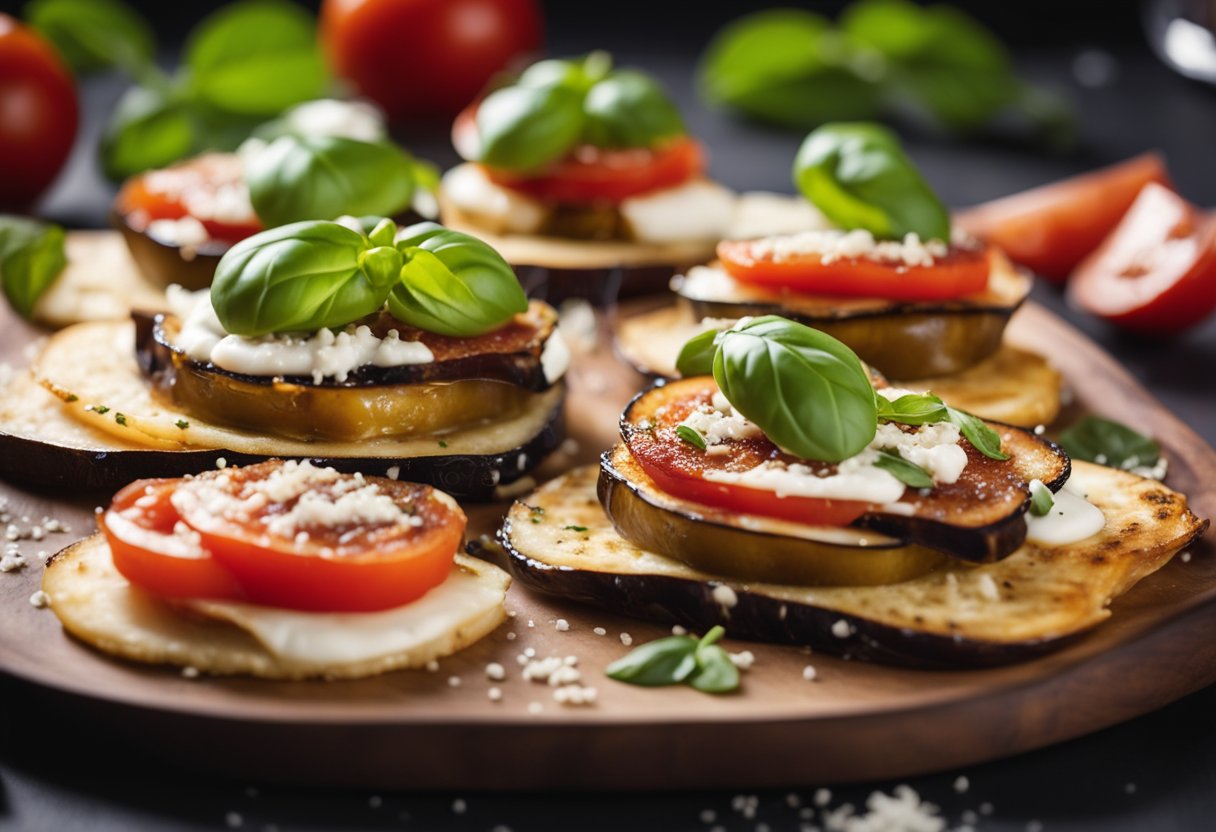
When we serve our light and crispy baked eggplant parmesan, choosing the right accompaniments can elevate the dish to its full, spectacular potential. We focus here on two prime categories to accompany our main star: pasta and side dishes.
Pasta Pairing
A well-chosen pasta not only complements the flavors of our eggplant parmesan but also appeals to those who cherish the comfort of carbs. We recommend opting for pastas like:
- Spaghetti: Traditional and simple, allowing our eggplant’s flavor to shine.
- Penne: With its tube shape, it catches the sauces wonderfully.
As for the pasta sauce, a classic marinara or a robust tomato basil sauce can bind the pasta and eggplant parmesan in delicious harmony.
Side Dish Recommendations
We like to balance our meal with side dishes that offer contrasting textures and flavors. Here are some side dishes that we find pair perfectly with our baked eggplant parmesan:
- Caesar Salad: Crisp romaine and a tangy dressing to cut through the richness.
- Sautéed Spinach: Lightly garlicky, it adds a healthful and flavorful touch.
Each of these side dishes can both contrast and complement the main meal, making our baked eggplant parmesan a complete and satisfying dining experience.
Special Considerations

When preparing our Light and Crispy Baked Eggplant Parmesan, we need to be mindful of guests’ dietary needs and allergies. By tweaking some ingredients, we can create a dish that’s accessible to more people without compromising on taste or texture.
Allergy-Friendly Alternatives
We can cater to individuals with allergies by making some simple swaps in our recipe. For those allergic to dairy, vegan cheeses offer a lactose-free alternative to traditional mozzarella and Parmesan. Additionally, for friends with gluten sensitivity or celiac disease, we replace bread crumbs with a gluten-free alternative, such as crushed gluten-free cereal or almond flour, to maintain that essential crunch.
Catering to Dietary Restrictions
Vegetarians can enjoy our baked eggplant Parmesan without modifications, but vegans require a bit more attention. We can replace eggs used for breading with a vegan ‘egg’ made from ground flaxseed or chia seeds mixed with water. Store-bought vegan egg replacers are also an option. To further cater to our vegan guests, ensuring that all our ingredients, including the marinara sauce, are free from animal products is crucial.
Cooking Techniques Explained

When we endeavor to make a healthier version of a classic dish like eggplant parmesan, it’s essential to focus on the cooking methods we employ. Specifically, we’ll dissect the benefits of baking over frying and the steps required to prepare the perfect breading.
Baking vs. Frying
In our quest for a light and crispy texture without the added fats, we opt for baking instead of frying. Baked eggplant parmesan offers a healthier alternative, with fewer calories and less fat.
- Frying: Typically involves submerging the eggplant slices in hot oil, which infuses them with additional fats and creates a greasier finish.
- Baking: Calls for a preheated oven, where we employ cooking spray to achieve crispiness without the excess oil.
By using the baking method, we ensure that our eggplant parmesan retains its desirable crispy exterior while aligning with a healthier profile.
Preparing the Breading
The breading process is crucial for achieving that sought-after crunch. We use a two-step system:
- Egg Wash: Dip the eggplant slices into an egg wash, which helps the breading adhere to the eggplant.
- Bread the Eggplant: Coat the moistened eggplant in a mixture of breadcrumbs and seasonings, ensuring each piece is evenly covered.
- Breadcrumbs: Use a combination of Panko for crunchiness and Italian seasoning for flavor.
- Seasonings: Can consist of garlic powder, salt, and pepper to enhance the taste.
Properly breaded and baked, the eggplant achieves a golden-brown exterior that is key to a delicious meal.
Creative Variations
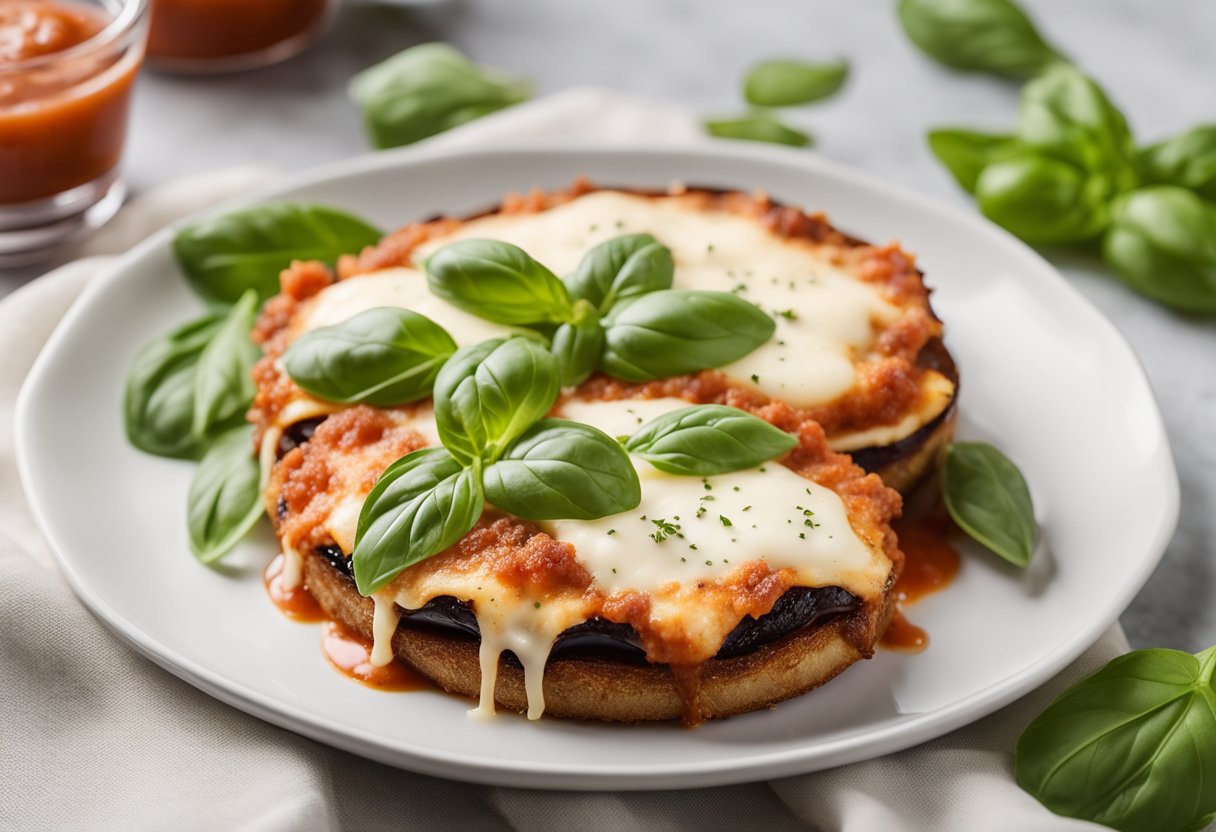
We all love the classic eggplant parmesan, but sometimes it’s fun to switch things up. Here we explore creative takes on this beloved Italian dish to keep your taste buds intrigued.
Twists on the Classic Recipe
Here are some innovative twists on traditional baked eggplant parmesan that can surprise and delight:
- Veggie Explosion: Add layers of spinach, mushrooms, or zucchini between the eggplant slices for a veggie-packed version.
- Different Cheeses: Swap out mozzarella for other kinds, like smoked provolone or gouda for a distinctive flavor profile.
For those aiming for fewer calories, consider using breading alternatives such as almond meal or crushed pork rinds as suggested by Healthy Foodie Girl.
Inspiration from Other Cuisines
Taking inspiration from around the globe can transform the classic Italian dish:
- Mediterranean Twist: Incorporate feta cheese, Kalamata olives, and a sprinkle of oregano to bring in Greek flavors.
- Mexican-Style: Give the dish a kick with some chipotle in adobo sauce mixed into the marinara and top with queso fresco.
By infusing the essence of other cuisines, we give a unique spin to our beloved eggplant recipes while respecting the original sentiment of the classic chicken parmesan; both share the allure of crispy, cheesy goodness that can adapt to countless variations.
Kitchen Essentials
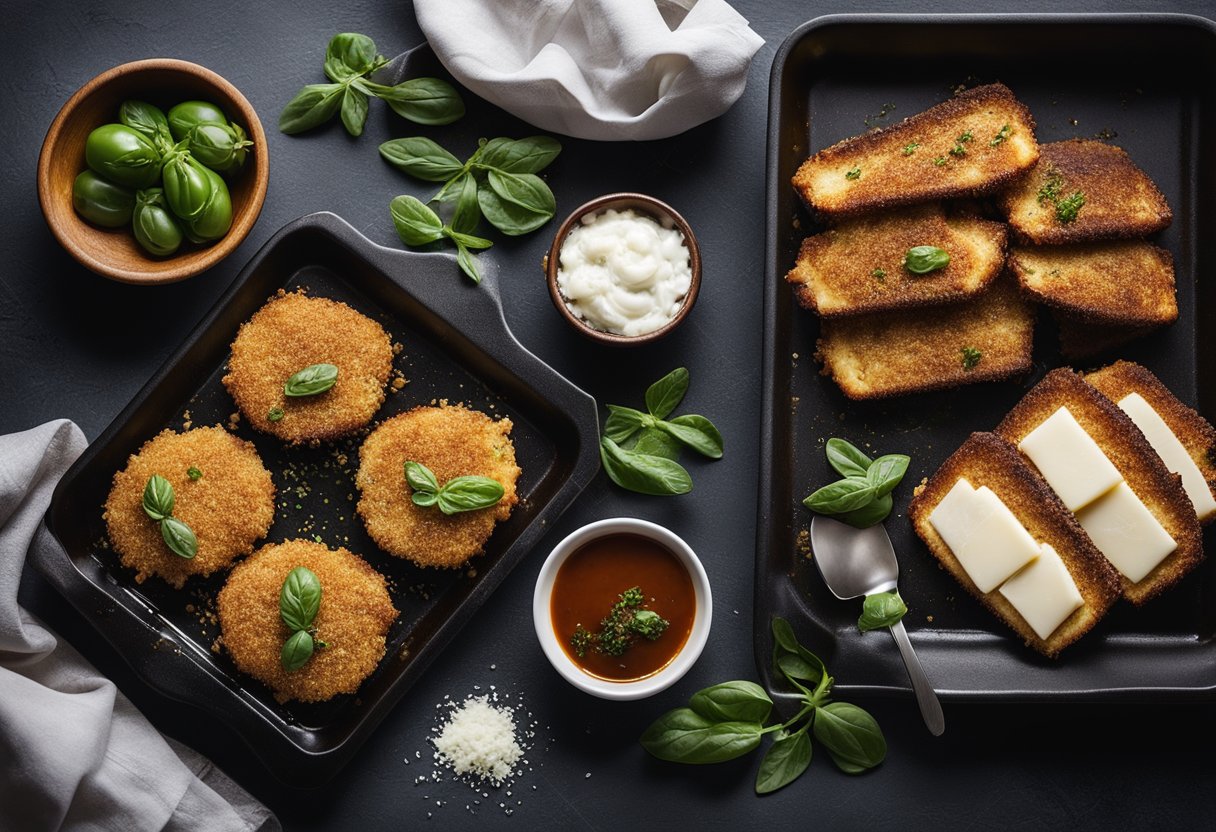
To achieve the perfect light and crispy baked eggplant parmesan, we need to focus on having the right tools. Let’s ensure our cookware and utensils are up to the task for this healthier version of the Italian classic.
Required Cookware
- Baking Sheets: For baking eggplant slices evenly, we require at least two large baking sheets. It’s crucial the sheets are spacious to prevent overlapping and promote crispy results.
- Casserole Dish: A medium to large casserole dish is necessary for layering our eggplant with sauce and cheese, ensuring the flavors meld together deliciously in the oven.
- Sheet Pans: Similar to baking sheets, extra sheet pans may come in handy if preparing a larger meal or for multitasking in the kitchen.
Utensil Recommendations
- Spatula: A wide spatula helps us easily flip eggplant slices on sheet pans without breaking them.
- Tongs: Having a pair of tongs provides us with a secure grip when removing hot eggplant slices from a baking sheet.
- Basting Brush: For lightly coating our eggplant with olive oil, a basting brush is a must-have to achieve that golden, crispy texture.
Mistakes to Avoid

When crafting a light and crispy baked eggplant parmesan, we must navigate through various missteps that can undermine the quality of the dish. Being aware of these errors will guide us toward achieving that perfect balance of flavors and textures.
Common Pitfalls
- Neglecting to Salt the Eggplant: Failing to salt eggplant slices can result in a dish that is watery and less flavorful. It is crucial that we salt the eggplant to draw out moisture, which concentrates the flavors and improves the texture.
- Peeling the Eggplant: Some might think you need to peel the eggplant for a more tender bite, but keeping the skin on actually adds to the dish’s structure and provides additional nutrients.
- Using the Wrong Salt: The type of salt we use matters. Opting for kosher salt, which has a larger grain, distributes more evenly over the vegetable slices and helps to efficiently draw out the moisture.
Improving Your Technique
- Ensuring Adequate Salting Time: Simply sprinkling salt on the slices won’t suffice; we need to give the eggplant time to expel moisture. A minimum of 30 minutes is recommended, but we can go up to an hour for thicker slices.
- Focusing on Even Slices: To ensure our baked eggplant parmesan cooks uniformly, we must cut our slices to the same thickness. Consistency is key to achieving that ideal tender yet firm texture in every bite.
Recipe

For our take on a healthier Eggplant Parmesan, we’ve curated a recipe that marries the classic comfort with a lighter appeal. By baking rather than frying, we maintain the delectable crispiness without the heaviness of oil.
Ingredients:
- 1 large eggplant, sliced into 1/2-inch rounds
- 2 large eggs
- 1 cup whole-wheat panko breadcrumbs
- 1/2 cup grated part-skim Parmesan cheese
- 1 tablespoon Italian seasoning
- 1/2 teaspoon garlic powder
- Salt and pepper to taste
- 1 cup part-skim mozzarella, shredded
- 2 cups marinara sauce, homemade or store-bought
- Cooking spray
- Fresh basil for garnish (optional)
Instructions:
- Preheat the oven to 400°F (200°C). Line baking sheets with parchment paper and lightly spray with cooking spray.
- Prepare the Breading: In a shallow dish, combine panko breadcrumbs, part-skim Parmesan cheese, Italian seasoning, garlic powder, salt, and pepper. In another dish, whisk the eggs.
- Bread the Eggplant: Dip each eggplant slice into the egg mixture, then dredge in the breadcrumb mixture, pressing to coat both sides. Place the breaded eggplant slices on the prepared baking sheets.
- Bake for 20-25 minutes, flipping halfway, until the eggplant is golden and crispy.
- Assemble: Spread a thin layer of marinara in the bottom of a baking dish. Layer half of the baked eggplant slices, top with more sauce, and sprinkle with half of the mozzarella. Repeat layers.
- Bake for 10-15 minutes, or until the cheese is bubbly and golden.
- Garnish with fresh basil, if desired, before serving.
We ensure this recipe is easy to make, leaning on the convenience of part-skim ingredients to enhance flavor without added fats. Serve it up for a meal that will satisfy cravings and promote health with every bite.
Building Your Cooking Confidence
When we embark on the journey of home cooking, it’s common to hit a few bumps along the way. Cooking eggplant parmesan can test our culinary skills, but it’s an excellent dish to build our cooking confidence. Here’s how we’ll master this healthy, crispy baked variation together:
- Start Simple: We begin with familiar ingredients. Eggplant, marinara sauce, and cheese are our core components. Seeing ingredients we recognize can boost our confidence before we even start.
- Organize: We gather our equipment and ingredients before we begin. There’s a term for this: mise en place, which means “everything in its place.” This preparation sets us up for success.
- Step-by-Step: We’ll follow the recipe one step at a time. No rushing—cooking is a process, and each step, from slicing eggplant to layering it with cheese and sauce, is a mini victory.
- Embrace Mistakes: If our eggplant slices aren’t uniform or we spill a bit of sauce, it’s okay. Mistakes are opportunities for us to learn and improve.
- Flavor to Taste: We trust our palates. If we taste our sauce and believe it needs more garlic or a pinch of salt, we’ll adjust it. Trusting our senses develops our cooking intuition.
| Task | Why It Helps Build Confidence |
|---|---|
| Choosing Recipes | Familiarity breeds comfort. |
| Prepping Ingredients | Preparedness reduces anxiety. |
| Tasting as We Go | Engages senses, hones skills. |
| Accepting Imperfections | Promotes a growth mindset. |
With every dish we make, our confidence grows. As we watch our baked eggplant parmesan turn golden and bubbly in the oven, we can’t help but feel a little prouder. It’s not just about the food; it’s about us becoming more competent and self-assured cooks.
Frequently Asked Questions
In this section, we explore common queries about creating a healthier, lighter version of eggplant Parmesan while ensuring that classic crispy texture and rich flavor.
What are the best practices for achieving a light and crispy texture in baked eggplant Parmesan?
To achieve a light and crispy texture, we recommend slicing the eggplant thinly and salting it to remove excess moisture. Prior to baking, a coating of panko breadcrumbs mixed with Parmesan cheese and herbs can add crunchiness. Baking at high temperature allows the exterior to crisp up without frying.
How can I make eggplant Parmesan in an air fryer with a panko crust?
Making eggplant Parmesan in an air fryer with a panko crust involves dipping eggplant slices in egg wash and panko mixture and then air frying them until golden. This method helps to create a crispy texture while reducing the need for excess oil.
What is the most effective method for baking eggplant to retain its health benefits?
The most effective method involves baking the eggplant without peeling, as the skin contains nutrients and antioxidants. Brushing the slices with a minimal amount of olive oil before baking can prevent drying out while still preserving the health benefits.
How can I calculate the nutritional value of a baked eggplant Parmesan dish?
To calculate the nutritional value, tally up the ingredients’ calories and nutrients and divide by the number of servings. Websites and apps designed for nutritional calculations can assist with determining the nutritional profile of your baked eggplant Parmesan.
What are some tips to reduce the carbohydrate content in a traditional eggplant parmesan recipe?
To reduce carbohydrates, you can substitute traditional breadcrumbs with almond flour or crumbled pork rinds for the coating. Additionally, using a low-carb marinara sauce can significantly decrease overall carb content.
Are there any common mistakes to avoid when trying to make eggplant Parmesan healthier and lighter?
Common mistakes include overloading the dish with cheese or sauce and not properly draining the eggplant of excess water, which can lead to a soggy dish. It’s also important to avoid overly thick slices, which might not cook evenly or crisp up as desired.


